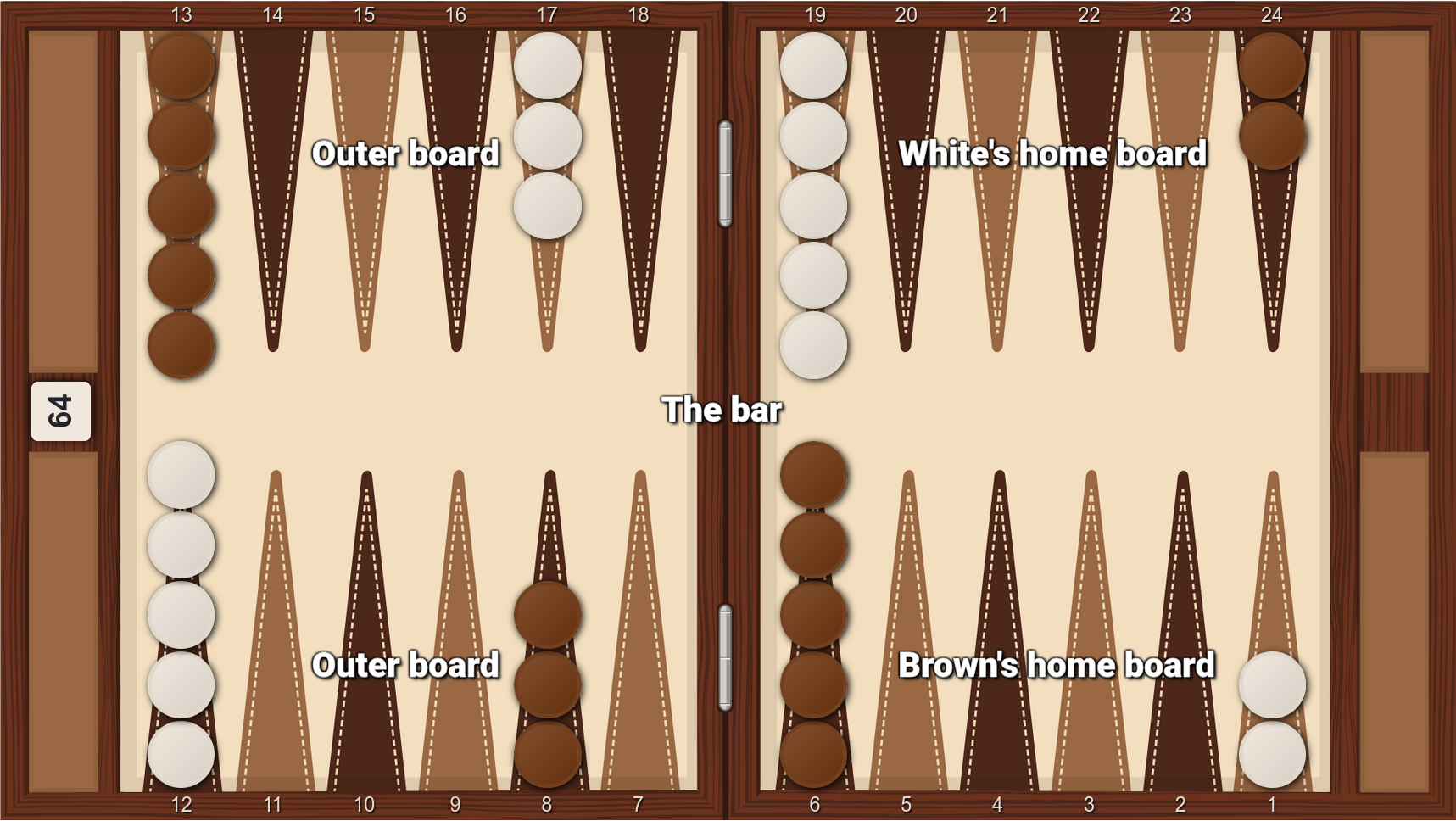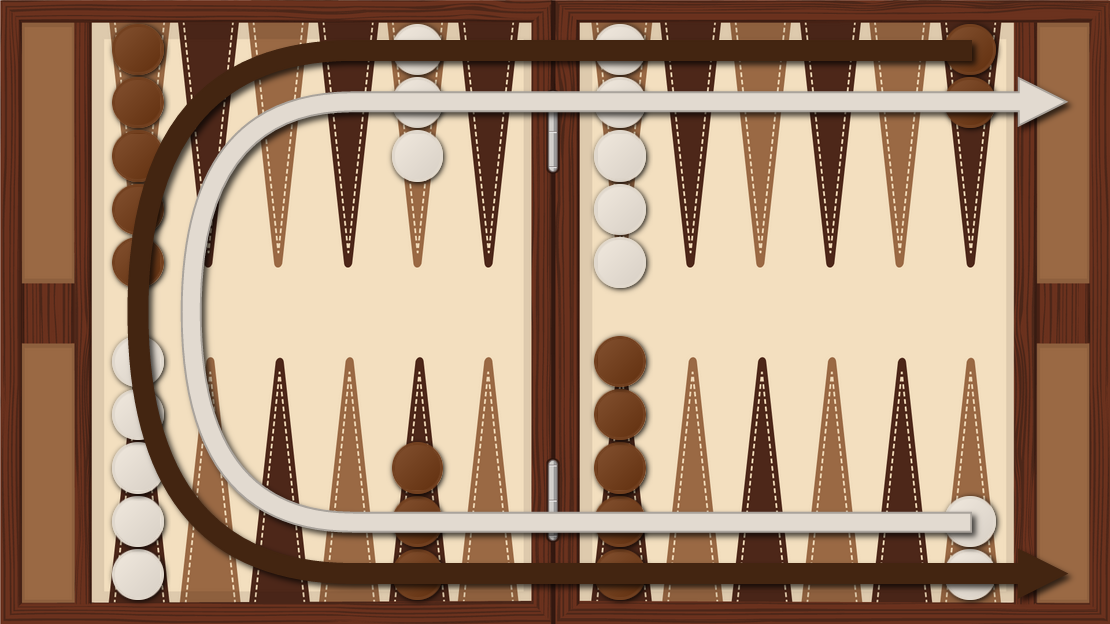Backgammon Rules
Backgammon History
As one of the oldest board games in the world, Backgammon has been played for nearly 5000 years.
Some people describe backgammon as “chess, with dice,” because it involves a combination of strategy and luck. This makes backgammon a super fun game for beginners, as it's possible to beat an experienced player right from your first game.
How do you play backgammon
Backgammon is a “race” game, where the two players race to get their checkers off the board.
During each player's turn, they roll two dice, and can move their checkers the number of spaces according to the numbers on the dice.
The object of backgammon is to move all your checkers around and off the board.
The first player to remove all their checkers from the board is the winner.
Backgammon board
A backgammon board is divided into two recessed halves, with a raised frame around the edge of each half. The ridge down the middle is called the “bar”.
The backgammon board is setup like this.
There are 30 checkers in total - fifteen light-colored checkers for one player, and fifteen dark checkers for the other player. Each player has two dice, and a cup to hold and roll their dice.
There are 24 narrow triangles on the board, alternating in dark and light shades. These are called “points,” or “pips”. There are 12 points in each half of the board and 6 points in each quadrant. Each point functions as a space on the board, along which you will move your checkers.
The points are all numbered from 1 to 24. In the following diagram, the dark checkers are yours, and the light checkers are those of your opponent.

From your perspective, you will see that point 1 (also known as your “ace point”) is in your own “home board”. Point 24 is in your opponent's home board. The “home board” of each player can be found at the diametrically opposite ends of the board.
You will be moving your own checkers towards your own ace point and off the board. Your opponent will see the numbers 1 to 24 from the opposite perspective (with their ace point in their own home-board etc).
Every backgammon board comes with a “doubling cube,” which is a dice with the numbers 2, 4, 8, 16, 32, 64 on its faces. The role of the doubling cube will be explained later.
Starting a game and rolling the dice
At the start of each game, the two players both roll a single die. The player who rolls the highest number gets the first move, using both of the numbers that have been rolled. If both players roll the same number, they both roll again until you both roll different numbers.
After the player with the highest number has had their turn, both players take turns to roll their dice and make their moves. When taking their turn, each player must always roll their two dice at the same time. Players must roll their dice so that they land flat in their right hand side of the board. If a die lands outside the board, on top of a checker, or does not land flat - then the dice must be rolled again.
Movement of checkers
With each roll, players will move their checkers around the board in opposite directions, towards their own home board / ace point.
You can only move your checker to an “open point” - which is a point that is either empty, occupied by your own checkers, or occupied by just one of your opponents checkers.
Backgammon demands a player use all the rolls they can. You cannot just forfeit one or both rolls. Sometimes you may be blocked by the situation of the board, but if there is a way to use both dice, you must make those moves.
On rare occasions you may be able to only use the first die, or only use the second die, but not both dice together. In these cases you must use the higher valued roll. This situation only occurs very rarely in real games of backgammon.

Hitting and entering
When there is a single checker on a point, it is called a “blot”. When your checker lands on a blot of the opposing player, that blot is “hit,” and your opponent has to remove their checker from the board and onto the bar.
If a player has one or more checkers on the bar - when it comes their turn to roll, they must first move these checkers back onto the board before they can move any other checkers. To re-enter a checker, you must move it from the bar onto an open point that corresponds to one of the numbers on the dice that you roll. If there are no open points corresponding to the number on a dice, then you cannot use that dice roll to move a checker back into the board. In this case, the checker will have to remain on the bar until your next roll.
Bearing off in backgammon
Only once you have moved all of your checkers around the board and into your home-board, can you start to move your checkers off the board completely.
Moving your checkers off the board is called “bearing off”.
How do you bear off? For each checker you want to move off the board, you will need to roll a corresponding dice roll with the point that it is on.
For example, if you have a checker on your 2 point, you will need to roll a 2 in order to “bear off" that checker from the board.
The first player to bear off all their checkers, wins the game.
Gammon definition
If at the end of a game, the losing player has not borne off any of their checkers, this is called “losing a gammon”. In this case the winner will achieve 2 points.
What is a backgammon?
If at the end of a game, the losing player has not only not borne off any of their checkers and also still has some checkers in the opponent's home board, this is called “losing a backgammon”. In this case the winner scores 3 points.
Doubling cube
The doubling cube is the dice included with your backgammon set, with the numbers 2, 4, 8, 16, 32 and 64 printed on it instead of the usual dice numbers.
At the beginning of a game, the doubling cube is placed on top of the bar or to the side with the number 64 facing upwards.This means that it hasn't yet been used.
The doubling cube can be used by either player during the game to “raise the stakes”.
What does this mean exactly in game play?
At some point one of the players might feel that they have a good chance of winning the game. When it is their turn to roll, instead of rolling that player can offer to double the stakes of the game.
In order to do this, the player will pick up the doubling cube and place it in front of his opponent with the face of the dice showing “2”.
The player's opponent then has two choices:
- Accept the doubling cube (this is called a “take”). This now means that the game is worth 2 points instead of 1 point
- Turn down the doubling cube (this is called a “drop”). This means that the opponent resigns the game and loses 1 point.
When a player takes the doubling cube, it is then in their possession and they are the only one that can offer to re-double the game stakes to 4.
At the end of the game, the winner of the game receives the number of points that is shown on the doubling cube.
In the case of a gammon, that number should be multiplied by 2. In the case of a backgammon, that number should be multiplied by 3.